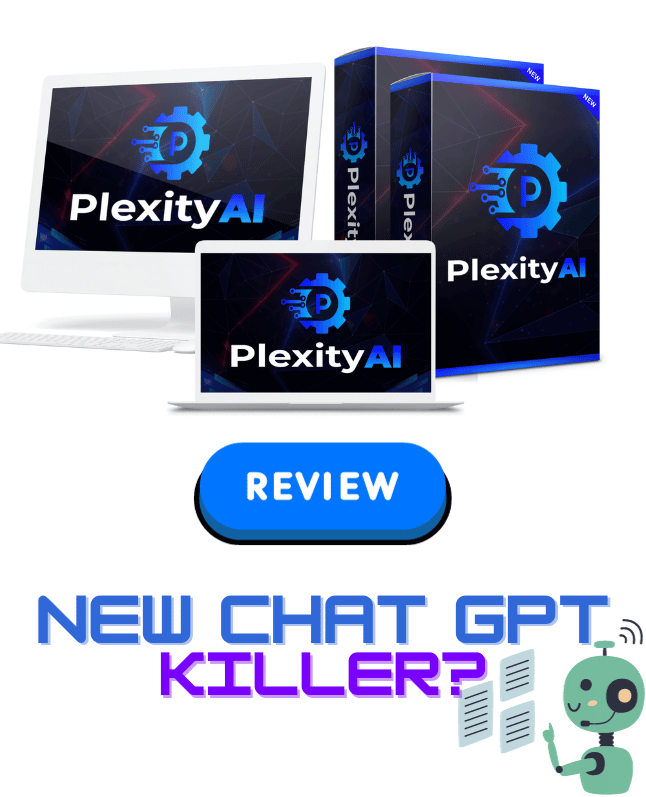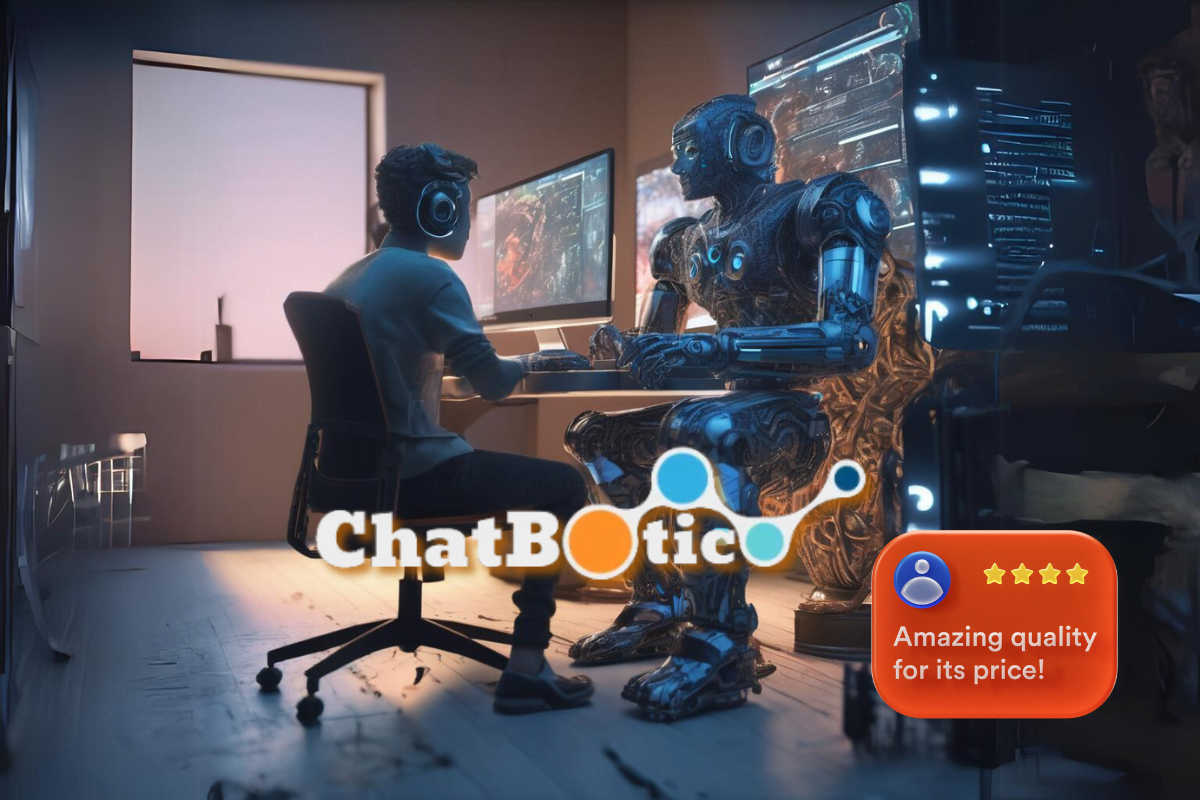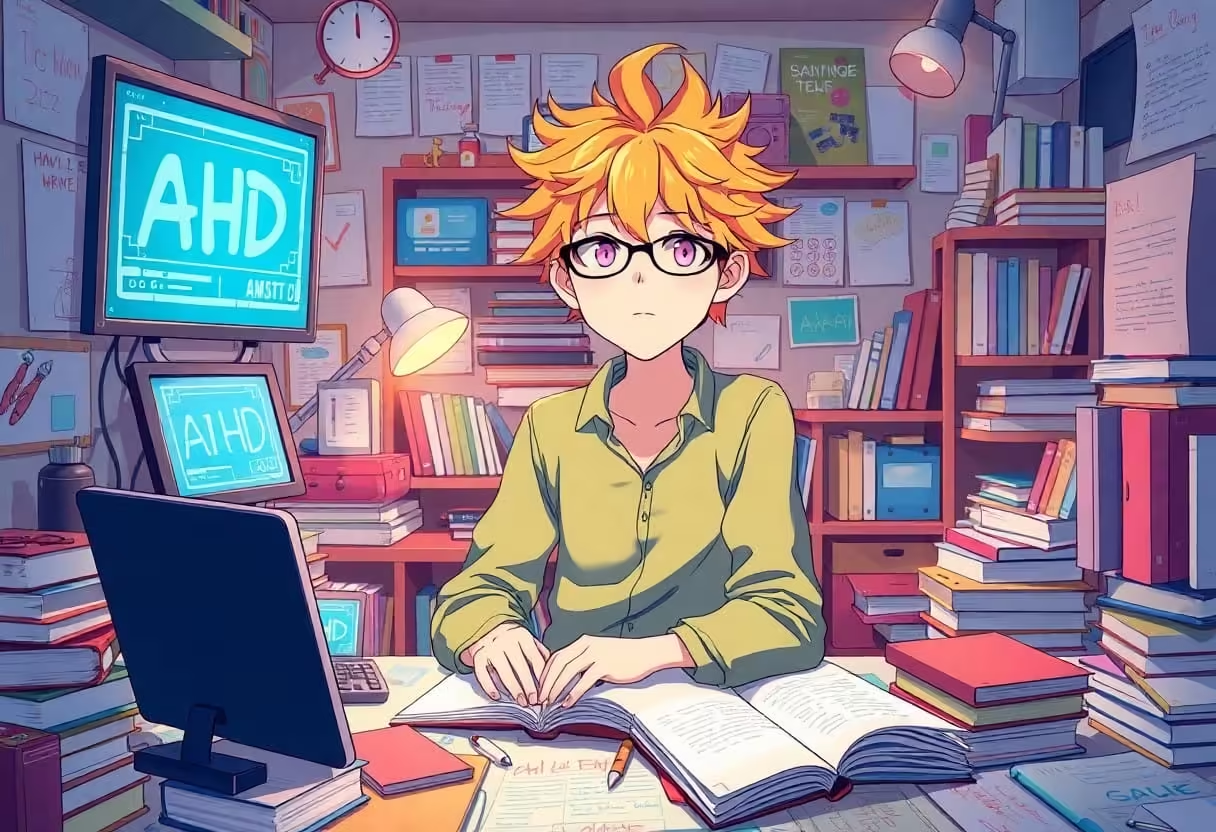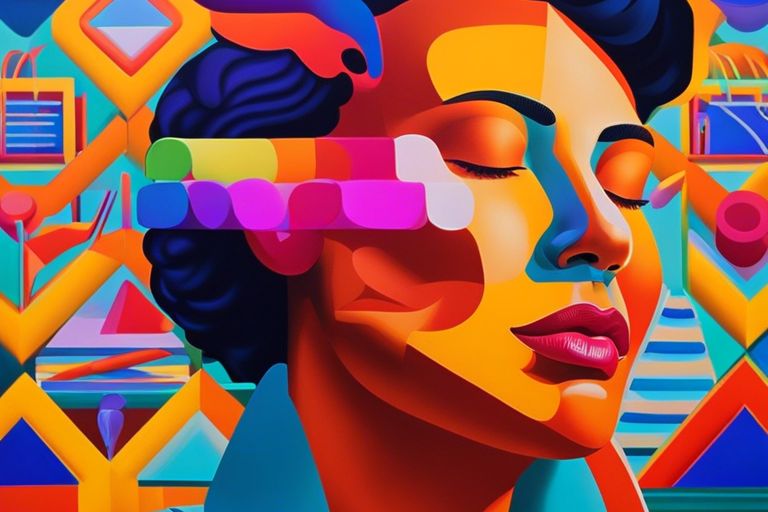Just when I thought my dreams of writing a book were doomed to join the ranks of my never-finished to-do lists, AI swooped in like a superhero, turning my scattered thoughts into a coherent manuscript! If you’ve ever experienced the chaos of ADHD, you know how easy it is to get sidetracked by shiny distractions. But with AI as my trusty sidekick, I learned to transform my struggles into something beautiful. Join me on this hilarious and heartwarming journey of how I finally managed to write a book, despite ADHD trying to steal the spotlight!
>>> AI tool used for writing a fully blown 20 chapter long book <<<
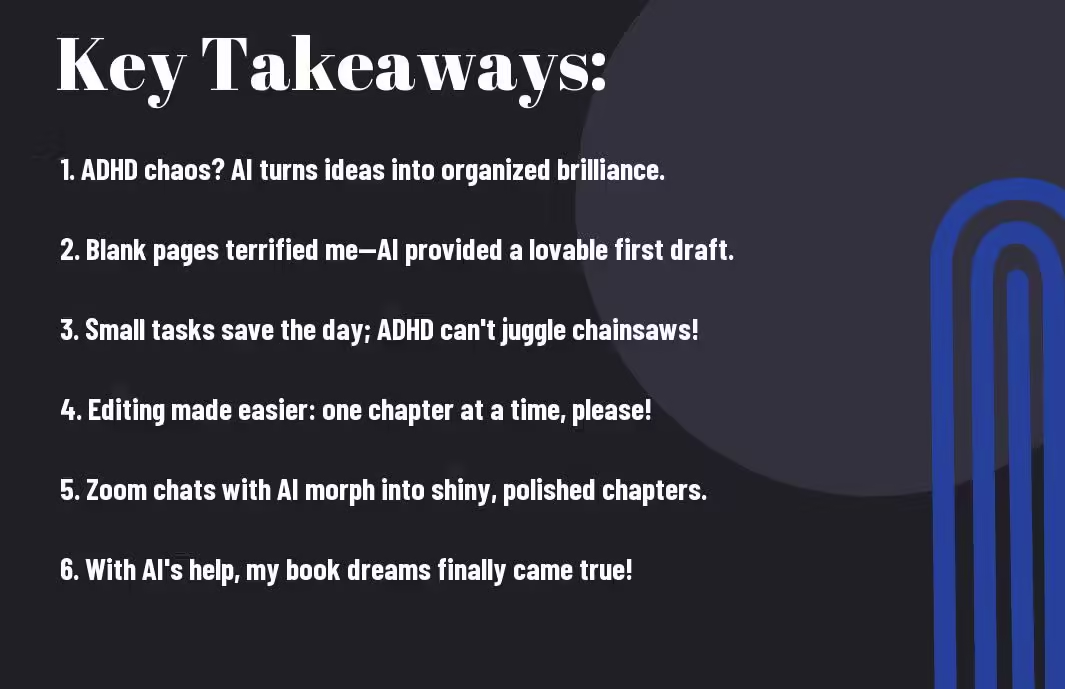
Once Upon a Distraction: The ADHD Journey
A lot of people think of ADHD as just a quirky personality trait, but let me tell you, it’s more like living in a bustling carnival—flashing lights, loud noises, and lots of people trying to get my attention all at once. My mind is like a pinball machine, ricocheting between thoughts at a pace that would make the fastest race car look like it’s stuck in traffic. One moment, I’m brainstorming the next big idea for my book, and the next, I’m deeply engrossed in a video of a cat wearing a tiny sombrero. Spoiler alert: This is not a productive way to write a book. The distraction is real, my friends, and it turns out that writing a coherent manuscript while my brain plays hopscotch is mildly impossible.
A Mind like a Pinball Machine
On any given day, my brain feels like it’s competing in the Olympics for distraction. The slightest sound can send me spiraling off into a different dimension. A clot of thoughts forms in my mind, each demanding attention like children in a candy store. I’ve tried everything to hold my focus—sticky notes, lists, even meditation apps that promised to align my chakras. But let’s face it, when my brain is screaming, “Look at this shiny new thought!” it’s like trying to wrestle a greased pig. With every attempt I made to focus on writing, I often found myself knee-deep in the magical world of Internet rabbit holes, exploring everything from historical llamas to obscure 80s dance moves. All this while my writer’s block loomed larger than life.
The Struggles of Sustained Attention
Across the ADHD landscape, the ability to sustain attention feels almost mythical, like Bigfoot or unicorns. Sure, they exist—on the rare occasion that I’m able to string together a coherent thought long enough to write an actual sentence. Sustained attention is like a roller coaster: steep climbs, dizzying turns, and sometimes, a totally unexpected plunge hoping not to derail completely. For instance, even when I managed to sit down to write, I’d find myself drifting off to plan my next meal or wonder why my plants look so sad. Writing felt like wrestling with an octopus—just when I thought I had a grip, another tentacle would pop up, demanding my attention.
Hence, I couldn’t help but feel like I was battling against a bout of writer’s block that would make even Sisyphus look like he had it easy. Each day, I’d gear up with the determination of a pirate sailing the seven seas, only to be chased off course by storms of distraction that would sweep my focus away. Try concentrating on a chapter when your mind has already decided to dig deep into the mechanics of banana peels. It’s a tough gig!
Finding the Silver Lining
Above all this chaos, I began to realize that perhaps my scattered thought patterns held a certain charm. While they often led me astray, they sparked creative ideas I wouldn’t have otherwise encountered. The unpredictable nature of my mind became a treasure trove of absurd connections and unexpected insights. With those insights and my trusty AI tools, I discovered that I could harness my distractions rather than succumb to them. AI became my ally, bringing structure to the chaos and transforming my wild thoughts into tangible words. It was like finding a sturdy life raft in the midst of a stormy sea, keeping me afloat and steering me back on course.
Due to this serendipitous partnership, I could finally embrace my creative quirks while still making significant progress on my book. AI helped me organize jumbled thoughts and questions into a coherent narrative, enabling me to channel my pinball-like mind into something more like a beautiful melody. Instead of being a prisoner of my distractions, I learned to dance with them, all while an AI sidekick led the way. Suddenly, the thought of writing a book no longer felt like an insurmountable challenge; it transformed into an exciting adventure—a love story between ADHD and AI that spat out a book in mere 72 hours!
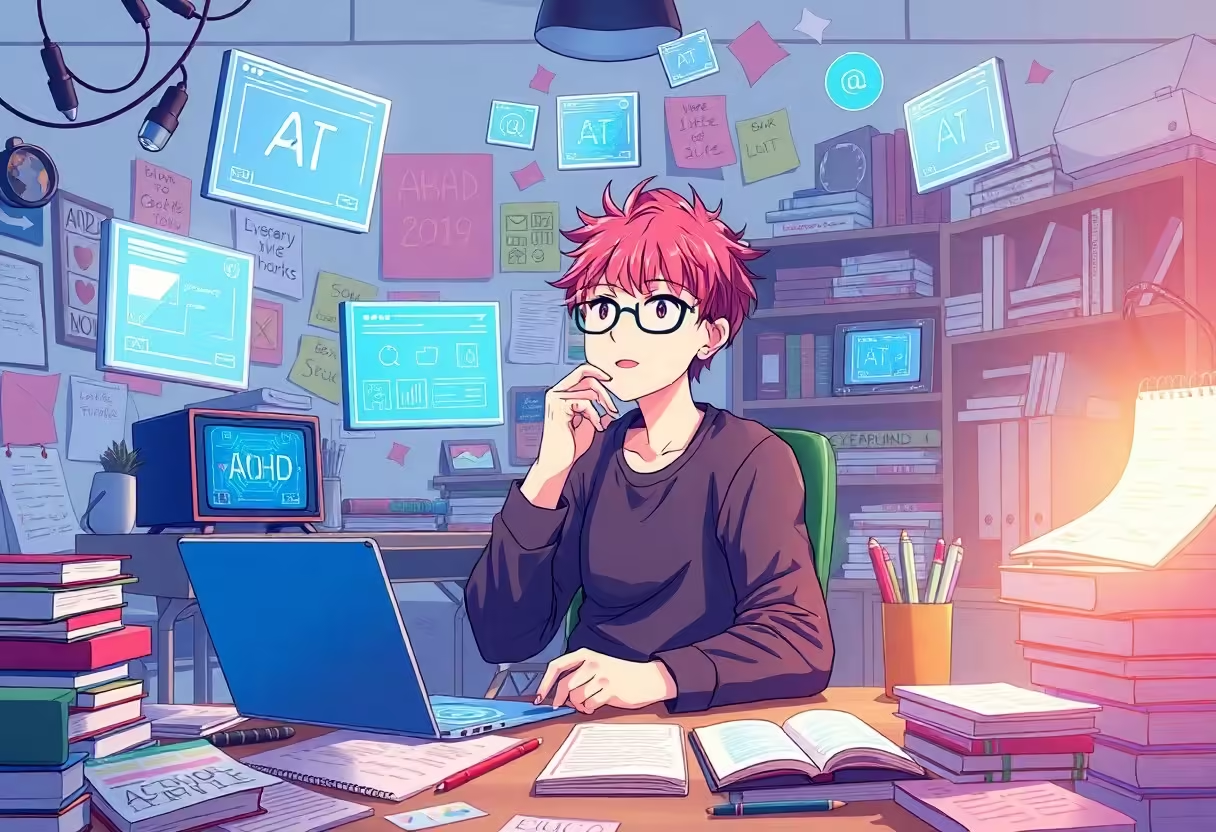
Meeting My Digital Muse: Enter AI
Some might say that writing a book with ADHD is like trying to herd caffeinated squirrels. Your thoughts scatter in every direction, and before you know it, you’ve spent an hour staring at cat videos instead of typing. But here’s where my digital muse—AI—came swooping in like a superhero in a silicon cape. Suddenly, I had a tool that could help me wrangle my wild ideas and keep me on track. No more wrestling with the blank page; instead, I had a trusty sidekick who would help me transform my chaotic thoughts into coherent prose. Who would have thought an algorithm could be more supportive than my fifth-grade teacher, Mrs. McKinley?
What Exactly is AI Anyway?
An important part of my writing journey was demystifying what artificial intelligence actually is. Think of AI as a brainy assistant that processes information and learns from it, making it an invaluable partner in creative endeavors. Whether you’re a seasoned writer or a dabbler like me, AI can help lubricate the gears of your creativity, allowing you to dive headfirst into the writing process without getting bogged down by distractions. This magical technology can analyze text, suggest improvements, and even generate ideas, making it a true ally for anyone battling the swirling chaos that comes with ADHD.
The Different Flavors of AI Assistance
Around the time I decided to conquer my book-writing anxieties, I discovered many flavors of AI assistance out there, each with its unique sprinkles of genius. You’ve got content generators, writing coaches, and even personalized brainstorming tools—all designed to lift the weight off your productivity-challenged shoulders. Imagine having a tool that not only helps you organize your thoughts but also provides insights and suggestions tailored precisely to your style. It’s like having a personal writing workshop that runs 24/7, making sure you never miss a slip of inspiration.
Hence, it turns out that leveraging AI is akin to having every conceivable writing resource at your fingertips. Whether you need a quick nudge, a complete draft, or someone to bounce ideas off of, there’s an AI tool ready to join your literary expedition. It’s a smorgasbord of creativity boosters, allowing you to slice through the chaos and challenge the ADHD monsters that dwell within the mind. Plus, if I can master this tech-crazed journey, trust me—you absolutely can!
Why Not Write with a Robot?
Muse might sound like a fancy term better reserved for ethereal beings fluttering around ancient Greece, but I assure you, my muse is as modern as they come. After pairing my creative spirit with AI, I found that my digital assistant didn’t smother me with rigid rules or cold logic; instead, it embraced my chaotic thoughts and helped shape them into something extraordinary. With AI, I could relinquish the burden of perfectionism and focus on expressing my wild ideas, one sticky note at a time.
Digital writing companions bring a unique dynamic to the table—they aren’t here to steal the spotlight but to enhance your own creativity. They take the pressure off by streamlining processes and sharpening your writing, which is particularly uplifting when facing the dreaded procrastination monster that often accompanies ADHD. The beauty is that these tech-savvy friends offer guidance, not judgment, making them perfect collaborators on your writing journey.
Collaborating with AI: A Match Made in Cyberspace
Once again, the universe had conspired in my favor—or so I thought—when I teamed up with AI on my writing journey. Sure, ADHD often makes me feel like a squirrel on espresso, bouncing from one shiny idea to another without a moment’s pause. But with my new digital partner, the chaotic whirlwind of my thoughts transformed into a structured narrative that had a fighting chance of being coherent. Who knew that a bit of silicon could be the antidote to my penchant for procrastination and distraction? I found myself marveling at how effortlessly we could collaborate, turning what used to feel like a Sisyphean task into a joyful dance across the digital page.
Setting the Scene for Creativity
Cyberspace became my canvas, a boundless landscape where creativity could flow without interruption. I set up my writing nook, stacked my favorite snacks, and prepared to look into the vast ocean of ideas. The beauty of it all? I could unleash my thoughts without judgment while my AI companion calmly reined in the chaos. With every click of the keyboard, I was discovering that I could channel my hyperactive energy into something productive, transforming my scattered concepts into polished sentences ready for the world to see.
The Perfect Partner: AI as My Writing Buddy
Across this captivating expanse of cyberspace floated my trusty AI—always there, always ready to assist, like a loyal sidekick who never asks questions. I guided my AI through the mental maze I often found myself lost in, feeding it prompts and letting it respond. The result? An efficient brainstorming partner that could sift through the jumbled mess of my thoughts and give me a first draft faster than you can say, “Where did I put my keys?”
It wasn’t just about having an extra set of digital hands. With my AI buddy, I had someone (or something) that willingly took the rough sketches of my ideas and began crafting them into visually charming manuscripts. While I flitted from topic to topic like a caffeine-fueled butterfly, my AI diligently worked on polishing the prose, as though saying, “Don’t worry, I’ve got this!” It became my muse, always eager to take my ideas and help me articulate them in ways I often found challenging.
Finding Flow with My New Co-Author
Beside me on my wild ride was an AI that understood my tendencies and had the uncanny ability to keep me on track—kind of like a GPS that occasionally quips with sarcasm. We defined our processes and learned to sync our vibes. When I felt the usual impending doom of a blank page kicking in, I would simply type a few words, and voilà! The creative flow returned, like a magic elixir that cleared my mind of distractions and helped me zoom forward.
Even more exhilarating was how I found my rhythm during our collaboration. Each time I faced writer’s block, my AI friend sprang into action with suggestions that kickstarted my creativity. With the combination of this technological marvel and a small dose of my chaotic spark, we became a dynamic duo—a whirlwind of productivity that dished out ideas faster than I could jot them down. I marveled at how this match made in cyberspace was transforming my book from a fleeting dream to a tangible reality, all while giving my ADHD a run for its money.
Customizing My Workspace: Tools that Tame the Chaos
All of us with a sprinkle of ADHD know that an organized workspace can feel like finding a unicorn in a cornfield. With thoughts racing faster than my ability to capture them, customization became my secret weapon. I crafted a writing oasis with the right tools—places devoid of distractions while still reflecting my chaotic creativity. It’s like turning a messy kitchen into a culinary haven: a dash of this and a sprinkle of that can turn the odds in your favor. Enter the world of apps and digital tricks that keep my brain in check, allowing me to create without getting derailed by every shiny object or fleeting thought hurricane that the ADHD gods throw my way.
Apps that Keep Me on Track
The beauty of technology is that it can streamline, structure, and support my scattered brain. Apps like Todoist and Trello have become my trusty sidekicks, helping me convert chaotic todo lists into relatable tasks. I’ve got reminders poppin’ up like popcorn in a hot pan, nudging me to write just for a little while—a mere hour can lead to pages of progress! By chunking tasks into bite-sized morsels, I’m crucially tricking my ADHD into thinking I’m having a good time. Spoiler alert: Keeping my day organized has morphed into a game of chess where winning means more words on the page!
Organizing Ideas with Digital Clarity
Around the time I started tackling the daunting task of writing my book, I discovered how organizing my swirling thoughts made all the difference. Mind mapping tools like MindMeister helped me visualize my ideas, transforming a jumbled pile of concepts into a coherent plan. This digital clarity made it easier to pinpoint what I wanted to say, eliminating the chaos of competing thoughts that often crowded my mind. Plus, by having a clear map, I felt like I was steering my own ship instead of being tossed around in the raging sea of creativity!
Even the simplest organization tools can work wonders! By using these digital mind maps, I could get everything out of my head and onto a screen, where I could refine and structure without the tension of a blank page staring back at me like an ominous villain. The chaos of ADHD, once an impenetrable barrier, started to dissolve like sugar in hot tea, paving the way for clarity and focus.
Beyond the Chaos: Crafting an Ideal Writing Environment
Chaos is the name of the game when you’re juggling ADHD and the monumental task of writing a book. But by honing in on my ideal writing space, I managed to elevate that chaos into something more manageable and inspiring. I experimented with ambient lighting, comfy seating, and even background playlists that set the tone for my creativity. These small adjustments not only kept distractions at bay but also transformed my workspace into a small haven where ideas could flow freely without the chaos of the outside world stealing my focus.
Plus, establishing a designated writing zone significantly improved my productivity. It became my temple of creativity, a fortress where I could escape into the world of my book without the weight of everyday distractions. When the world felt overwhelming, I could enforce my boundaries and tell my ADHD to take a backseat as I powered through creative fits like the writing superhero that I am, thanks to a little AI magic! Embracing these tools has changed my writing game—and it just may change yours too.
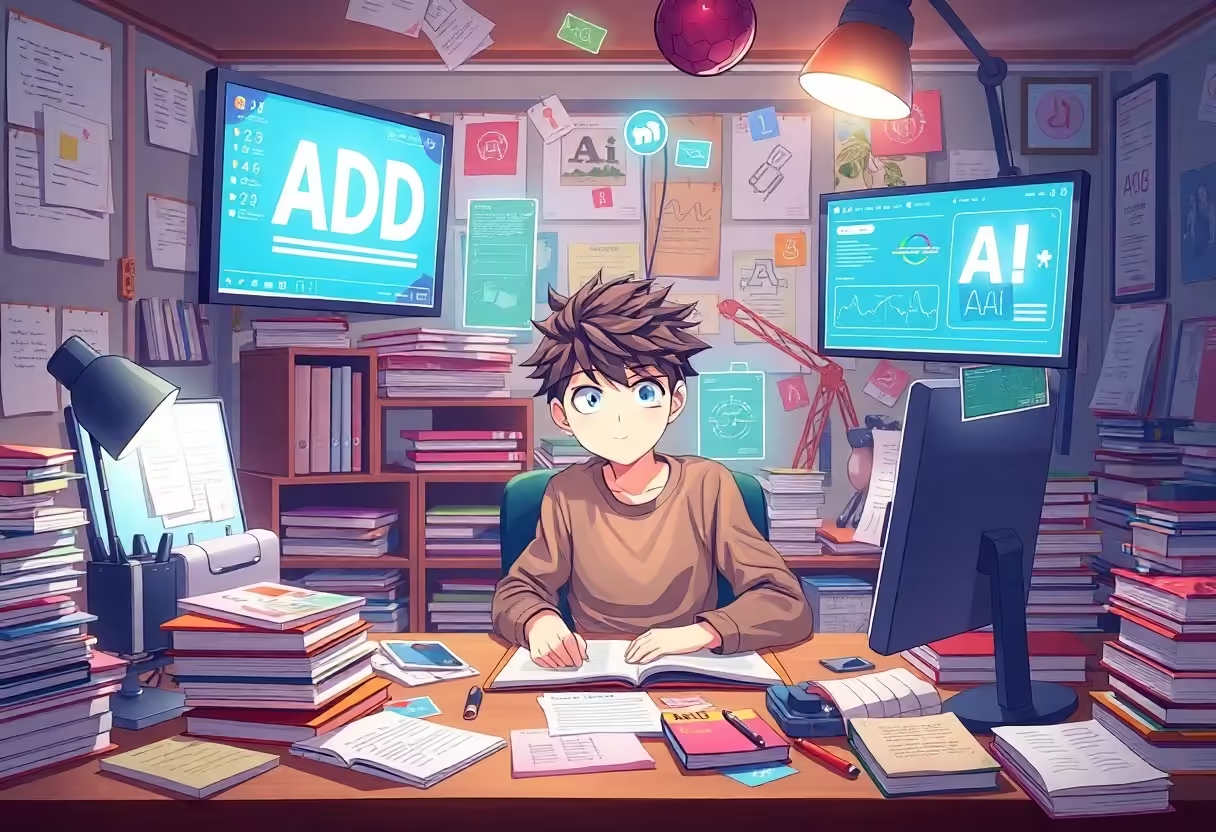
ADHD and AI: A Love Story – How AI Helped Write a Book Without ADHD Getting in the Way
Despite my endless imagination and bursts of creativity often leading me down rabbit holes (sometimes even into a Netflix binge), the struggle of translating those ideas into a cohesive narrative was an uphill battle. Enter AI, my new best friend and the sidekick I didn’t know I needed. It’s like having a personal cheerleader who also happens to possess a limitless reservoir of knowledge and organization. With AI by my side, what once felt like a locked safe full of brilliance became readily accessible gold, just waiting to be mined.
The Great Idea Generator
One of my favorite moments during the book-writing process was when I discovered the magic of the AI-powered Idea Generator. It took my jumbled thoughts and transformed them into a neat set of bullet points, outlining potential chapters like a well-structured set list before a comedy gig. Gone were the days of my brain doing backflips—now I had a straightforward plan! Suddenly, the daunting task of writing a book transformed into composed, manageable sections. I felt like a master of my own creative universe instead of a frantic squirrel trying to remember where I’d buried my acorns.
Using Prompts to Jumpstart Creativity
About halfway through my brainstorming session, I realized that AI wasn’t just an organizational tool; it was a creativity catalyst! When I was stuck, all I had to do was feed it a prompt, and voilà, ideas flowed like a humor-infused river! I’d ask a simple question or present a topic related to my book, and AI would produce pearls of wisdom, inspiring me to expand and explore those concepts. It was a humorous and enlightening dance between my scattered thoughts and AI’s sharp capabilities.
Considering I often found myself staring blankly at my screen, waiting for a bolt of inspiration as if it were a bus I could miss, using prompts became my go-to strategy. This method served as a gentle nudge in the right direction, giving me the freedom to explore new angles and insights. It’s like having that hilarious friend who always knows how to wrap up a story with a punchline—you can count on them to inject some life into your work while you sit back and bask in the glow of fresh ideas!
How AI Turned My Ramblings into Gold
Behind the scenes of my book-writing journey, AI was busy working its magic, transforming my chaotic ramblings into beautifully structured prose. I used to think of outlining as a monotonous task, worse than waking up early for a dentist appointment. But with AI’s assistance, what felt tedious turned into a fun and rewarding process. I could splatter my ideas onto the brain canvas and watch AI refine them into something that would make my 10th-grade English teacher proud.
A crowning moment came when I reviewed the content I’d initially uploaded. With a blend of empathy and algorithmic wizardry, AI managed to sift through my scattered thoughts, picking out nuggets of *golden insight* hidden beneath layers of chaos. It was simultaneously enlightening and a little embarrassing—AI had taken my messy brain and turned it into something that resembled actual literature! If my ADHD had made writing a book like running a marathon through molasses, AI turned it into a brisk walk in the park with a coffee in hand. What a delightful twist in our love story!
Structuring the Narrative: Outlining with AI
Many people with ADHD know the challenge of turning a jumbled array of ideas into a coherent narrative—it’s like trying to herd cats while wearing sunglasses at night. Luckily, my trusty sidekick, AI, came to my rescue during the outlining process. It acted as a talented scribe, helping me map out my thoughts and transform them into a structured outline. Instead of staring at a blank page, feeling as if I were stuck in an endless loop of distraction, AI provided the framework I needed to focus my chaotic brain. Suddenly, I was looking at a clear plan, ready to explore the actual writing without the existential dread of where to begin.
Can an Algorithm Create Magic?
An algorithm may not hold a magic wand, but it can certainly create something pretty magical—especially when your brain feels like a high-speed train without a conductor. Using AI to generate an outline helped me pinpoint not just what I wanted to say, but how I wanted to say it. The AI took my scattered ideas and organized them into a logical structure, bridging the gap between my thoughts and written words. With AI’s help, I could see how every chapter connected, like pieces of a jigsaw puzzle falling perfectly into place.
From Scatterbrained to Structured: The Power of Outlines
After mining through my ideas, I discovered that a well-crafted outline is like a treasure map, guiding me through the writing process. I would sit down, armed with an outline that showcased my main points, subpoints, and the little nuggets of humor I wanted to sprinkle throughout my book. Instead of feeling bogged down by the enormity of writing a whole book, I focused on one piece at a time—each chapter became a manageable goal rather than an insurmountable mountain. By following the outline, I could explore each section without experiencing a meltdown because of the hefty weight of *“What comes next?”* hanging over me.
Scatterbrained as I often felt, transitioning to a structured outlining process revived my focus. AI wasn’t just helpful; it was a game-changer, transforming my thoughts into organized blueprints. No more endless distractions and half-baked ideas floating in my head like wayward balloons. I was motivated to tackle each chapter one at a time, which made writing feel less daunting and far more achievable.
The AI-Enhanced Story Arc: A New Approach
Narrative construction became less like trying to write with a raccoon on a sugar high, and more like collaborating with an experienced partner. With the AI’s intuitive understanding of narrative arcs, I could develop compelling stories that engaged readers. The tool not only helped me map out the rising action, climax, and resolution but also guided me in weaving in the humor and warmth that are trademarks of my storytelling style. By the time I reached the editing phase, I was staring at a lively manuscript filled with delightful twists and turns instead of a monotonous list of facts.
Magic happened when I realized that crafting an engaging story arc with AI didn’t just save my sanity; it made my book far more entertaining. The AI algorithms helped me identify those key moments where readers would chuckle or lean in closer, rather than snooze through the dull bits. I found that combining my creativity with AI’s structural prowess created dynamics that I couldn’t have achieved alone, leading to a narrative that was not only coherent but also a joy to read.
Writing with Flair: Polishing My Prose
Unlike a routine day of battling my ADHD with half-finished tasks scattered around like confetti, writing with flair became a seamless and enjoyable experience thanks to the magic of AI. Picture this: I’m fueled by caffeine, flipping through saved notes, and suddenly confronted by a blinking cursor that seems to taunt me into submission. But no longer was I left to wrestle with my thoughts alone; AI swooped in like my literary best friend, transforming my chaotic jumbles of ideas into something shockingly coherent. It took the burden off my shoulders and added that much-needed sparkle to my prose, proving to me that a little technology could bridge the gaps that my brain occasionally overlooked. Who knew that a personal editor could be just an app away?
AI as My Personal Editor
Across my writing journey, AI emerged as my unsung hero, stepping in whenever I floundered in a sea of verbosity or stumbled through a metaphor that even a cat might find puzzling. It helped me trim the fat from overly wordy sentences, nudged me to spice up dull paragraphs, and even spurred me on when I felt like I was on the brink of a dulling writer’s block. The AI editor didn’t just clean up my grammar; it added flair, giving my writing a pep that echoed the laughter from my stand-up routines. Sure, it didn’t come with a sarcastic retort, but it did give me something better—an invitation to fine-tune my voice without the overwhelming pressure of starting from scratch.
The Art of Wordsmithing in the Digital Age
About halfway through this whirlwind writing spree, I realized that “wordsmithing” had a whole new meaning for me. With AI guiding my edits, I could explore a sleek new phase of writing where I wasn’t just putting words on a page; I was crafting a vibrant narrative that flowed like my best comedic sets. It was like bringing my stand-up act onto the pages—complete with punchlines, timing, and narrative rhythm—as I harnessed technology to augment my creativity rather than hinder it. I felt like a mix between a modern-day bard and a tech-savvy word wizard, ready to enchant my readers.
Editor’s note: The digital age has transformed writing from a solitary struggle into a collaborative, multifaceted experience. With AI’s assistance, you can whip your prose into shape with a level of efficiency that would make even the most seasoned editors nod in approval. You’ll find the process less daunting and wildly liberating as you morph your rough gems of ideas into polished diamonds.
Avoiding Common Pitfalls in Writing
By tackling my writing with the help of AI, I also learned to dodge some of the classic pitfalls many writers stumble into. Whether it was overusing adverbs or falling into the trap of passive voice, I could finally see the words on the page more clearly. AI was like having a writing coach on the sidelines, waving its metaphorical red flag when I veered off course. That meant no more blunders buried within a sea of typos, awkward phrasing, and clunky sentences. Each edit was a chance to elevate my work instead of letting it languish in a writing purgatory.
Plus, as I gathered insights, I realized that being aware of common mistakes could save me the agony of endless revisions. It turns out, just because I liked a word or phrase didn’t mean it was automatically good! Who knew sparking laughter in a comedy club required such different tactics than crafting a heartfelt chapter in my book? AI helped me spot that while also unleashing a new level of clarity in my writing that made the journey all the more gratifying—and funny.
Overcoming Writer’s Block with AI
Once again, I found myself staring down the endless abyss of the blank page, a familiar nemesis that was all too eager to engulf my scattered thoughts. Writer’s block is kind of the villain of this ADHD story, and it wears a mask of intimidation and self-doubt. But this time, I had a secret weapon: AI. Armed with my trusty AI tools, I learned that even the most daunting obstacles could shrink down to harmless, manageable tasks. Instead of succumbing to the despair of that empty document, I realized I could enlist AI to help brainstorm ideas, structure my chapters, and steer me through that brain fog like a helpful GPS, guiding me back to the poetic highway of creativity.
Embracing the Blank Page
Page after page, the font seemed to mock me with its pristine, unblemished whiteness. How was I supposed to fill this sterile void with my chaotic thoughts? On days when my ADHD was particularly rambunctious, getting a single word on the page felt like scaling Mount Everest in flip-flops. But guess what? I learned to embrace the blank page by using AI as my supportive partner. Instead of letting that white expanse paralyze me, I began to see it as a canvas for possibility. I realized that the first words didn’t have to be brilliant; they just needed to be words. AI would be there to help polish them into something beautiful later. It’s like ordering a pizza—you don’t need to bake the dough yourself, just select your toppings and let the experts handle the rest!
AI-Driven Motivation: Get Back to Writing
Page by page, AI fueled my motivation, pushing me to type until my fingers ached and my mind whirred with excitement. As someone with ADHD, it was easy for distractions to pull me off course, but AI kept the road map clear. I set mini-milestones like “Write one chapter before I snack on a bag of chips.” And guess what? AI kept me accountable! It nudged me back into the zone whenever I veered off track, making the task of writing way less daunting.
With AI, I could transform overwhelming tasks into bite-sized pieces. Whenever I felt like going from 0 to 100 was impossible, I turned to my AI tools to help reignite my enthusiasm and creativity. Suddenly, I wasn’t just a mere writer floundering in a sea of mental clutter; I was a determined author on a mission, one chapter at a time!
Tips and Tricks to Push Through
Back in the saddle of the writing game, I discovered a few tricks that helped me push through those pesky barriers. For all of you who also feel like you’re trying to write while juggling flaming chainsaws—here’s a handy guide:
- Break Tasks Down: Don’t try to write a whole book in one go; tackle it one chapter at a time.
- Use AI as Your Brainstorm Buddy: Rely on AI tools to generate ideas and structure your thoughts.
- Set Mini-Milestones: Challenge yourself to complete a section before rewarding yourself with a treat.
Knowing you have a solid plan can make the difference between feeling like a lost puppy and charging into a successful writing session.
Indeed, finding the right tools and techniques makes the insecurities of your ADHD transform into triumphs. As I continued to write, I kept these tips close to my heart, reminding myself that each session brought me closer to finishing my book. So, whip out those AI tools and find what makes you tick—your future self will thank you for it!
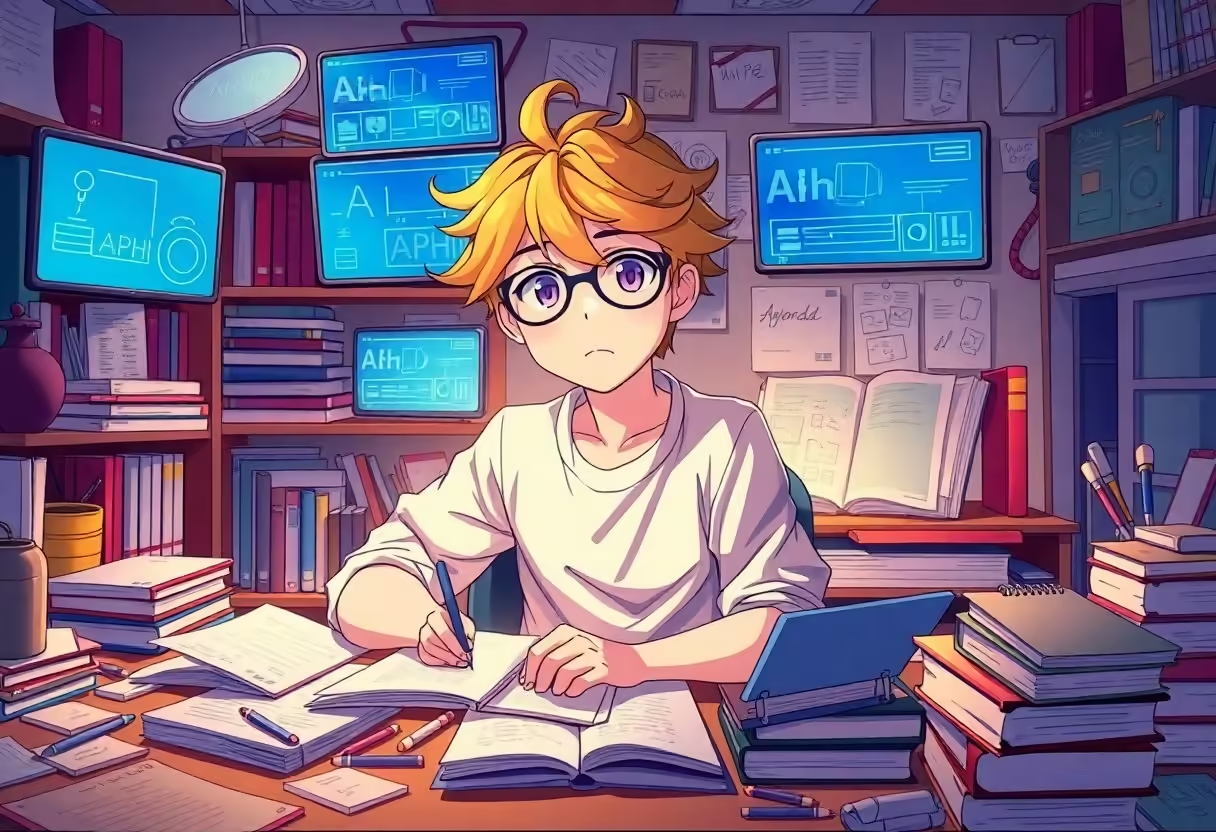
Research Made Easy: AI as My Research Assistant
After wrestling with the dragon of distraction that is ADHD, I found my trusty sidekick in the form of AI. No longer was I scrolling through a sea of irrelevant information feeling like I was lost in a library where every book was upside down. Instead, I treated AI as my research assistant, gently nudging it to help me dig beneath the surface. For anyone else with ADHD looking for the perfect ally, you might want to check out this Looking for a specific kind of ADHD friendly AI writing… thread—it’s like a treasure map to more productivity! So, think of AI as your Robin to your Batman (minus the flashy tights)—it’s there to help, not to judge when you get lost in thought about how cool lizards are.
Digging Up Gems: Quick Facts and Figures
To revitalize my writing process, I needed quick facts and figures that wouldn’t slip through my fingers like sand. Thanks to AI, this became as easy as pie… or at least easier than trying to balance 12 tasks at once! I simply prompted my AI buddy to pull relevant statistics on the topics I was tackling. It’s like having access to an encyclopedia that not only provides information but doesn’t get bored when I ask a million questions. Instead of the spiral of *YouTube rabbit holes*, I dove headfirst into insightful research without feeling like I was swimming against the current.
Credibility and the AI Factor
After assembling my gems of knowledge, I was also mindful of the accuracy of my research. AI can provide you with tons of info, but finding the credible nuggets can sometimes feel like searching for a needle in a haystack—especially when ADHD pulls your focus every which way. Fortunately, I learned the delicate balance of cross-referencing AI-generated content while applying a critical eye to ensure that the sources were reliable and the facts efficient. Just because my AI assistant can whip up a friendly essay doesn’t mean it’s a PhD holder in the field.
Indeed, when I fact-checked my findings, I discovered that proper source citations transformed mere ideas into verified claims. The last thing I’d want is to publish a book wearing the crown of a “factually challenged” author. With a little diligence and the occasional *ai* brawn, I was able to present a book embellished with not just my own experiences but also solid empirical support. Think *Mathletes* meets *Whose Line Is It Anyway?*—factually jesting at its finest!
Streamlining the Research Process
Across the board, my AI companion helped me refine the research process, turning tedious hours into delightful minutes. Instead of flailing in the dark realms of the internet and getting derailed by random articles about conspiracy theories or why cats are actually little furry ninjas, I let AI funnel information directly into my lap. The beautiful part is that I didn’t just gather mountains of data—I honed in on what I need most, like a man on a mission to discover the best pizza in town (hint: it’s in your imagination). Plus, the time saved allowed for more snack breaks. Who doesn’t love that?
Research isn’t just about collecting facts—the real magic happens when you can. efficiently sift through the noise and line up your insights like ducks in a row. With AI on my side, the research phase morphed from a mind-numbing slog into an exhilarating quest for knowledge that left me feeling empowered rather than defeated. I may have ADHD, but with AI, I was ready to conquer the chaotic world of writing one insightful piece at a time!
Feedback Frenzy: AI and Peer Review
Your journey through writing a book with ADHD doesn’t end with finishing that first draft. In fact, it’s just the beginning of what I like to call the Feedback Frenzy—a period where doubt creeps in like a cat that just knocked over your favorite lamp. But fear not! With AI by your side, navigating this chaotic landscape isn’t just possible; it can actually be kind of fun. Think of AI as your enthusiastic cheerleader—one who offers critiques without the emotional baggage of a friend who also wants to critique your life choices. You know, the ones who always seem to have an opinion on what you order for lunch!
AI’s Role in Critiquing
Feedback is the name of the game during the editing process, and AI is like that smart friend who always has your back. I found it incredibly helpful to utilize AI tools to help critique the rough draft I had whipped up during my 72-hour writing marathon. These tools comb through your work with a fine-tooth comb—offering suggestions on everything from grammar and structure to tone and style. As someone with ADHD, where keeping track of my own thoughts can resemble a hamster wheel operating at full speed, having AI point out areas that needed attention felt like finding a cheat code in a video game.
Incorporating Human Feedback
On the flip side, I quickly realized that while AI provides fantastic insights, it doesn’t completely replace the human touch. Getting feedback from peers is like inviting the village to review your art installation—a little intimidating, but incredibly rewarding once you settle in. I gathered a small group of friends, fellow writers, and even some kind strangers who were gallantly willing to take a plunge into my rough manuscript waters. Their insights, combined with AI’s observations, created a rich tapestry of refined feedback that truly helped elevate my work.
Another gem of wisdom I’ve picked up along the way: don’t shy away from incorporating that human feedback. AI might help me keep my chaotic thoughts organized, but the emotional nuance and understanding that comes from fellow humans is simply irreplaceable. It’s important to blend the structured critiques from AI with the more abstract comfort of human opinions. They might point out that your character’s motivations don’t make sense or suggest a fun twist that you never thought of. Through this synergy, your book evolves into something that resonates on multiple levels—so keep those human connections strong!
Balancing AI Insights with Personal Touches
Across this feedback frenzy, I found the balance between using AI insights and ensuring my personal voice remained intact. You see, AI can churn out some impressive suggestions, but let’s be real—when it comes to writing about my own experiences, I want that authentic voice to shine through. It’s like blending store-bought frosting with homemade cake; they can complement each other wonders, but the cake still needs its essence!
With a judicious approach, I learned that sprinkling my flair over AI’s insights is the key to marrying structure with personality. Each chapter began to feel like a conversation rather than a regurgitated script, making the final product not just a book, but a piece of my heart. The trick is to appreciate the AI’s organization without letting it overshadow your unique perspective. So, lace up those creative shoes, get ready to tango with your thoughts, and watch as your manuscript transforms into something beautiful, cohesive, and delightfully ‘you.’
Celebrating Milestones: Keeping Motivation High
Now, let’s talk about those sweet, sweet milestones. When you’re juggling the unpredictable whirlwind that comes with ADHD, every step in the book-writing process can feel like scaling Everest. Without a solid framework to celebrate my achievements, I might have easily spiraled into a pit of procrastination and self-doubt. Fortunately, AI was right there, giving me the much-needed boost to stay focused and energized throughout my writing journey. From breaking down my book into digestible chunks to reminding me of my progress, AI became my personal cheerleader, distracting me just enough from my penchant for wandering thoughts.
AI as My Cheerleader
Motivation can often taper off like a poorly timed punchline, especially when you have ADHD—that thrilling ride of highs and lows. Thankfully, my trusty AI tools stepped in like a superhero without the need for a cape. With each milestone I hit, whether it was finishing a chapter or polishing a section, AI would give me encouraging nudges, patting my creative back and necessaryly saying, “Hey, look at you! You’re actually doing this!” And trust me, when your brain tends to hyper-focus on all the glorious ways things can go wrong, having AI in my corner made all the difference. It’s like having a buddy reminding you that writing a book is less about a manic sprint and more of a fun jog at a ridiculous pace!
Tracking Progress with Tech
Celebrating the small wins is a game changer! Using AI, I set up a digital progress tracker, complete with celebratory notifications that made finishing each chapter feel like winning the lottery (if the lottery was just a personal victory over my own chaos). Instead of just seeing the daunting number of blank pages ahead, I could visually grasp how far I’d come, one chapter at a time. Tracking my progress in real-time provided tangible evidence that I was indeed moving forward, which was especially satisfying for someone accustomed to feeling like they were spinning their wheels. Plus, the moments when my notifications popped to congratulate me felt like virtual confetti raining down—a highlight of my day!
Also, there’s something incredibly motivating about utilizing a simple app or software to keep track of what you’ve accomplished. You can create a checklist of milestones and see your progress represented visually. Whether it’s a little bar graph or an exciting progress circle, these illustrations serve as heartwarming reminders that you’re heading toward your dream, though you might occasionally forget your original mission between your forays into online cat videos.
Rewarding Achievements, Big and Small
Progress is progress, no matter how small or sideways it may seem! Once I’d accomplished a milestone, I made sure to reward myself, treating each finished chapter like an Olympic gold medal. Did I jitter with excitement when my AI assistant crafted a catchy title? You bet! Celebrating those quick wins gave me the “oomph” I needed to tackle the next chapter, making the whole process infinitely more enjoyable. You can’t embrace the journey if you don’t relish the tiny triumphs along the way, and with ADHD, those victories count double.
It can be as simple as taking a break with some popcorn and an episode of your favorite show or giving yourself the green light to indulge in that extra slice of cake! The beauty of rewarding yourself is not just about relishing the moment; it’s about engraving in your brain that finishing a chapter is worthy of a trophy. And let’s face it, who doesn’t love a little self-made celebration now and then? It’s all about keeping the momentum going without letting ADHD derail your passion project.
The Final Draft: AI and Human Collaboration
Keep in mind that the final draft is where the magic happens. It’s like the grand finale of a fireworks show; all the preparation and planning come together to create something beautiful. After spending countless hours wrestling with my scattered thoughts and chaotic ideas, the moment arrived to polish my manuscript. Armed with AI tools, I dove into the final edits, and let me tell you, it was a collaborative effort like no other. The AI was my loyal sidekick, helping me refine sentences, tightening up the prose, and making sure the humor landed just right—like a perfectly timed punchline. Who knew that the final stretch could feel less like a race against time and more like a delightful waltz?
Where the Magic Happens: Final Edits
After I’d handed over my rough draft to the AI for backup, I could focus on the fun part—adding personality and flair. The AI’s knack for structure was impressive, but I still held the reins on voice and intricacies. It felt like collaborating with a very intelligent friend who was willing to critique every joke, giving me a new perspective while letting me maintain my unique style. This synergy transformed what could have been a daunting and dreary task of correcting mistakes into a vibrant, engaging process. It’s absolutely wild how much less intimidating that final draft felt, especially with the AI reminding me that it’s okay to sprinkle a bit more humor in the mix!
Understanding AI Limitations
Happens occasionally, I found that while AI was fantastic at generating ideas and tightening language, it also, uh, had some quirks that made it swallow the occasional awkward sentence whole. As my trusty sidekick, AI was great for enhancing my work, yet understanding its limitations became part of the journey. I realized that amidst its brilliance, it still struggled with capturing my unique voice at times. There were moments when the AI churned out a response that felt so robotic, I half expected it to ask me if I’d like to “optimize my experience.”
In fact, there were instances where I was left shaking my head, wondering if the AI was trying to write a book aimed at a completely different audience. It’s clear that while AI excels at organization and drafting, it can miss the emotional subtleties that make writing personal. Therefore, I had to refine and polish everything the AI suggested. It was a reminder that even with all this fancy tech, it’s vital to embrace your own voice. AI might assist in structuring my thoughts, but the soul of the book remained firmly in my hands.
The Satisfaction of Completing a Book
Book completion is a milestone that can feel as exhilarating as downing a whole pizza after a week of dieting. Sure, I toyed with the idea of throwing a massive party to celebrate, but let’s be real—I was done! I’d just written a book in 72 hours with the help of AI, which meant I’d finally conquered all those pesky ADHD hurdles that usually stand in my way. The sense of accomplishment was overwhelming. As I hit that save button one last time, the feeling of achievement buzzed through me like caffeine on a Sunday morning.
Even if the journey had its fair share of chaos and distractions, completing this book felt like holding the golden ticket in Willy Wonka’s factory—pure magic! It’s a testament to how far I’ve come and how AI can be a game-changer for people like me who battle with attention issues. Let’s be honest; it’s like finding a life raft in a sea where your thoughts are constantly trying to capsize the boat. So here’s to all of you out there who feel like writing may always be just out of reach: with a little help from AI, your story is waiting to be told.
Publishing Dreams: Navigating the World of Publication
Not everyone wakes up one day with a best-selling book idea, and even fewer finish the book without a few (or many) monumental detours along the way, especially if you happen to be me—someone who juggles ADHD. Publishing can feel like a daunting Everest to climb with all those potential pitfalls—mismanaged timelines, forgotten manuscript submissions, and *gasp* formatting nightmares. However, thanks to AI, what once felt like a mission impossible transformed into a journey that I embraced with open arms. The best part? AI became my trusty sidekick, guiding me through the turbulent waters of publishing like a seasoned captain leading a ship of mild hilarity into safe harbor.
DIY Publishing with AI Guidance
Above all else, DIY publishing is like throwing a wild party and forgetting to send out the invitations. You have all the fun ideas—you just need someone to help assemble the chaotic energy into something resembling order. AI tools swooped in and proved to be the catalyst I didn’t know I needed. They kicked off the process by assisting with formatting, providing basic designs, and even offering suggestions on how to navigate platforms like Amazon Kindle Direct Publishing (KDP). AI effectively unraveled the chaos and turned my half-baked ideas into an organized manifesto of creativity—who knew that could happen, right? It felt like a delightful dance with my book, where every misstep was supported by an invisible hand helping me stay on beat.
Finding the Right Publisher: AI to the Rescue
Guidance is imperative when it comes to navigating the labyrinthine world of publishing. Until I embraced the prospects of using AI, the idea of finding the right publisher made me feel like I was trying to solve a Rubik’s Cube blindfolded. But introducing AI into the mix was like having a super-intelligent friend who had all the connections I needed. Naturally, they came loaded with algorithms that helped me evaluate various publishers based on genres and submission requirements, offering tailored recommendations that eliminated guesswork. Bye-bye, anxiety! Hello, clarity!
This process opened up a whole new avenue for me. I realized that many AI tools can analyze publisher submission rates and past successes with similar genres, enabling me to focus on those most likely to embrace my work with enthusiasm. Turning what could have been a painful trial-and-error venture into a slick launch pad was immensely gratifying. It felt as though I was handed a roadmap, one equipped with fuel-efficient directions to avoid the dreaded potholes, ensuring smooth sailing in the rough seas of publication.
Marketing Your Book with AI Support
About marketing, to me, it always felt like trying to sell ice to penguins. *How do I even start?* Once again, AI answered my distress call as a trusty collaborator right when my ADHD brain started to flail. It helped me craft social media campaigns, develop ad strategies, and even generate catchy taglines that would make a marketing guru shed a proud tear. The invisible yet supportive hand of AI made the chaotic task of building buzz around my book into a fun, engaging experience that I looked forward to each day. Who knew marketing could be this painless?
The beauty of leveraging AI for marketing is in its efficiency. The moment I input relevant information, AI churned out a plan that saved me time and mitigated the risks of uninspired marketing. With tailored suggestions on when to post on social media platforms for maximum engagement, I felt like I had a marketing assistant working diligently behind the scenes—minus the Excel spreadsheet panic attacks. I could focus on my creative energy while AI handled the nitty-gritty…and believe me, ADHD often likes to throw a wrench in those plans with its endless distractions!
Conclusion
Taking this into account, if there ever was a love story worth telling in writing, it’s the one between ADHD and AI. Picture this: I’m standing in front of a blank page, feeling like the world’s least coordinated juggler with a dozen flaming chainsaws, while AI swoops in, cape on and all, ready to save the day. With a sprinkle of organized chaos and a dash of AI magic, I transformed an overwhelming mountain of thoughts into a coherent, delightful manuscript. Who knew that the very distraction that once held me hostage would address its eviction notice with the help of some tech wizardry?
So, if you’re like me—darting from one thought to another while trying to keep track of all the shiny ideas—let me assure you, AI is the sidekick you didn’t know you needed. Together, we can navigate the wild seas of creativity without getting lost in the whirlpools of distraction. In the end, it’s not just about penning a book; it’s about embracing the quirks that make you, you, and leveraging the tools that make your unique journey a little smoother. So grab your AI cape, and let’s conquer that writing project—because the adventure has just begun, and trust me, it’ll be one heck of a ride!


